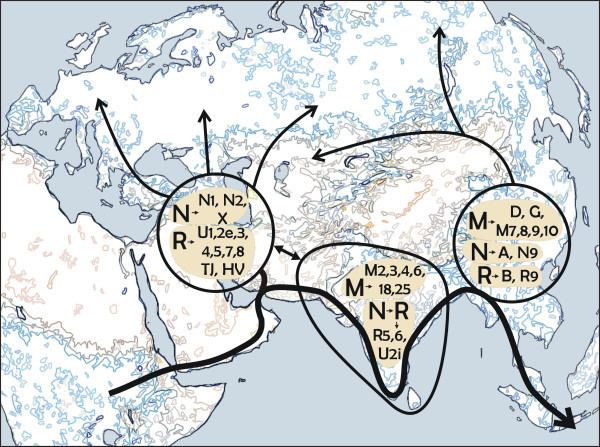Possible time of origin 50,000 YBP Ancestor R11'B Defining mutations 8281-8289d | Possible place of origin Southeastern Asia Descendants B4, B5, B7 | |
 | ||
In human mitochondrial genetics, haplogroup B is a human mitochondrial DNA (mtDNA) haplogroup.
Contents
Origin
Haplogroup B is believed to have arisen in Asia some 50,000 years before present. Its ancestral haplogroup was haplogroup R.
Its greater variety is in China. It is conspicuous that haplogroup B may have its earliest diversification in southern China and/or Southeast Asia.
Distribution
Haplogroup B is found frequently in southeastern Asia. A subclade of B4b that is labelled irregularly as B2 is one of five haplogroups found in the indigenous peoples of the Americas, the others being A, C, D, and X.
Because the migration to the Americas by the ancestors of Indigenous Americans is generally believed to have been from northeastern Siberia via Beringia, it is surprising that Haplogroup B and Haplogroup X have not been found in Paleo-Siberian tribes of northeastern Siberia. However, Haplogroup B has been found among Turkic, Mongolic, and Tungusic populations of Siberia, such as Tuvans, Altays, Shors, Khakassians, Yakuts, Buryats, Khamnigans, Negidals, and Evenks. This haplogroup is also found among populations in China, Indonesia, Iran, Iraq, Japan, Korea, Laos, Madagascar, Malaysia, Melanesia, Micronesia, Mongolia, the Philippines, Polynesia, Taiwan, Thailand, Tibet, and Vietnam.
Although haplogroup B in general has been found in many samples of Altaic-speaking populations of Siberia, the subclade that is phylogenetically closest to American B2, namely B4b1, has been found mainly in populations of southern China and Southeast Asia, especially Filipinos and Austronesian speakers of eastern Indonesia (approx. 8%) and the aborigines of Taiwan and Hainan (approx. 7%). However, B4b1 has been observed in populations as far north as Turochak and Choya districts in the north of Altai Republic (3/72 = 4.2% Tubalar), Miyazaki and Tokyo, Japan (approx. 3%), South Korea (4/185 = 2.2%), Tuva (1/95 = 1.1% Tuvan), and Hulunbuir (1/149 = 0.7% Barghut).
Tree
This phylogenetic tree of haplogroup B subclades is based on the paper by Mannis van Oven and Manfred Kayser Updated comprehensive phylogenetic tree of global human mitochondrial DNA variation and subsequent published research.
Popular culture
In his popular book The Seven Daughters of Eve, Bryan Sykes named the originator of this mtDNA haplogroup Ina.
